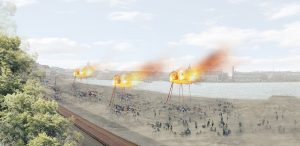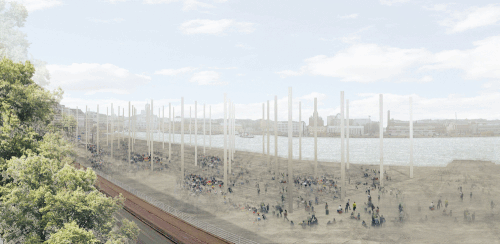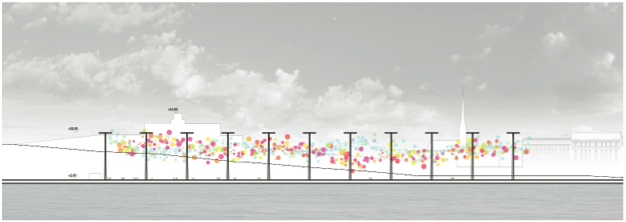I, together with an awesome team (Jussi Nuortimo Noora Laak, Jukka Itälä, Jussi Ukkonen) took part in the Next Helsinki -competition. This essay was part of our competition entry, and was written by me with contributions from Jussi Nuortimo.
Burning Platform is a platform for large-scale art installations / communal events / popular happenings. The platform is enabled by a flexible grid of 44 pylons with water, electricity, and relevant technical installations. In essence, Burning Platform is a museum without a museum that engages the city in a state of continuous transformation. View full entry!
Burning platform
A vibrant, livable and proud city cannot just reinvent itself without acknowledging its history. The fabled Times square remodel of the 1990s rebuilt the place with elements that already were quintessential to the NY way of living
When applied to Helsinki: a successful reimagining of Helsinki builds on the elements that constitute Helsinki.
Continous re-contextualization
The purpose of art is to recontextualize the things we see in our everyday lives. After Dalí, the image of the rotary telephone or a mundane wall clock were never the same, after Magritte, a pipe was never just a pipe.
Urban design has similar relation to the visual and urban experience. Buildings, and especially museums and other containment vessels for art, aim at re-contextualising the urban experience. For outsiders, this might even be possible: one cannot think of Sydney without the opera or Bilbao without the G. For locals, they are hollow attractions, places designed for someone else. After 15 years of rain and the mundane, even the flashiest attraction becomes a backdrop.
The Burning Platform reconceptualizes the museum by altogether removing the barriers between the museum and the city, by blending these in creative chaos. These temporal large-scale public works comment, annotate and enrichen the notable places in vicinity. One cannot compete or replace the allure of the stunning waterfront. But one can annotate and recontextualize it.
As a site for art and popular happenings, The Burning Platform allows for the continuous reimagining and rethinking of the historical center of Helsinki. Because the site is in a state of flux, the normal relations spatiality creates are transformed. The Burning Platform aims to disrupt the calcified notions of ownership of places in cities. A temporal instance of happening (happenstance) can, merely by existing, reframe the buildings and space around it. Thus, we empower people to question the established power relations they are subject to by the cities.
By placing art works of huge, even unprecedented size to the already thick semiotic mesh that includes the Finnish Industry Federation, Palace of the President of the Republic, the main Orthodox and Lutheran churches, head offices of a traditional pulp and paper company and the City hall of Helsinki, we create openings for ruptures, recontextualizations and new meanings. By making the exhibitions part of the cityscape, we invite all the citizens and visitors to take part in these semiotic openings.
 The central and monumental location of the South Harbor, together with the massive scale of public art happenstances afforded by the Burning Platform, makes it possible to re-imagine the whole monumental central Helsinki as a place for experiences. These experiences are not built for tourists – by being temporary and ever-changing, they create scenery and experiences for Helsinkians and visitors.
The central and monumental location of the South Harbor, together with the massive scale of public art happenstances afforded by the Burning Platform, makes it possible to re-imagine the whole monumental central Helsinki as a place for experiences. These experiences are not built for tourists – by being temporary and ever-changing, they create scenery and experiences for Helsinkians and visitors.
When the Kiasma museum for contemporary art was built in Helsinki in the late 1990s, it created a controversy by establishing itself as the backdrop for the rider statue of Marshal Mannerheim, the quintessential Finnish war hero. Many commentators thought that building a museum right behind the statue would somehow diminish the value of it. Naturally, what happened was the complete opposite of that. Kiasma museum accents and highlights the statue, makes it stand out and live.
Having a place for temporary but large scale exhibitions of both art and popular culture, we can have a similar iterative process for the whole monumental waterfront of Helsinki. The happenstances create unique relations with the built environment surrounding it. Some buildings will be aggrandized in worth, other will be diminished. Some buildings will be proven able to create meaningful relations with different conceptions of large-scale public art, others won’t.
The materiality of the instances in the the Burning Platform is by definition temporal. With the advent of true virtual reality we can preserve a snapshot of time/space – an instance. Through the use of VR headsets and immersive sensory deprivation, it is possible to enter these instances; they are modeled as the exact replica of their material counterpart, yet still different; in a different space, unfettered by the constraints of physics. The art changes as perspective becomes a choice. The virtual space also transcends geography. Combined with with unlimited copies and frozen time, this virtual turns the concept of a local, inherently temporal space in its head, making time a mere axis in the spatial archive. And when perspective becomes a choice, the semiotic mesh of the urban environment can also be chosen, replayed, varied, reimagined. The same happenstance can be experienced elsewhere.
Since the space is open for meanings and interpretations, the projects can easily transgress notions of “art space”, even “public art space” or “community art space”. We create possibilities. The space can be used to everything from high Art installations to open Restaurant day -food carnival bbq feasts to community art pieces to kanye West preaching from the crane.
One transformation is certain. Burning Platform uses scale and position to recreate the Market Place as the optimal art experience vantage point. Ironically, this makes the whole waterfront area more accessible and interesting for citizens, fights back the tourist-y kitch vendors.
 Scale constructs the the experience of the city. The Burning Platform breaks the scale of urban experience.The rupture in scale repositions the experience of urban dweller. A building breaks the scale only once. To have something that you cannot familiarize yourself with… to have something that requires the at the same time requires the attention of all citizens yet blends in the cityscape… is to create a continuous reconceptualization of the meaning of the city, open for everybody.
Scale constructs the the experience of the city. The Burning Platform breaks the scale of urban experience.The rupture in scale repositions the experience of urban dweller. A building breaks the scale only once. To have something that you cannot familiarize yourself with… to have something that requires the at the same time requires the attention of all citizens yet blends in the cityscape… is to create a continuous reconceptualization of the meaning of the city, open for everybody.
Future is a process
Future is fluid: a design, building or even a concept that tries to bring a leap to the future will always stay as a testament to the time when it was conceived. Although a temporal Burning Platform is more future proof than a static museum, it is still very much the image of the 2010s Helsinki, with new- found international pride and the dangerous and sexy spontaneity of the Restaurant day.
City is a living and evolving thing, where every structure has a lifespan. This applies to possibilities and happenstances – world has a limited energy for temporal art platforms. Once experiences become dull, once physicality and spatiality are spent, the Burning Platform can be abandoned – filled with terminals, cars or buildings, whatever people then find necessary.


